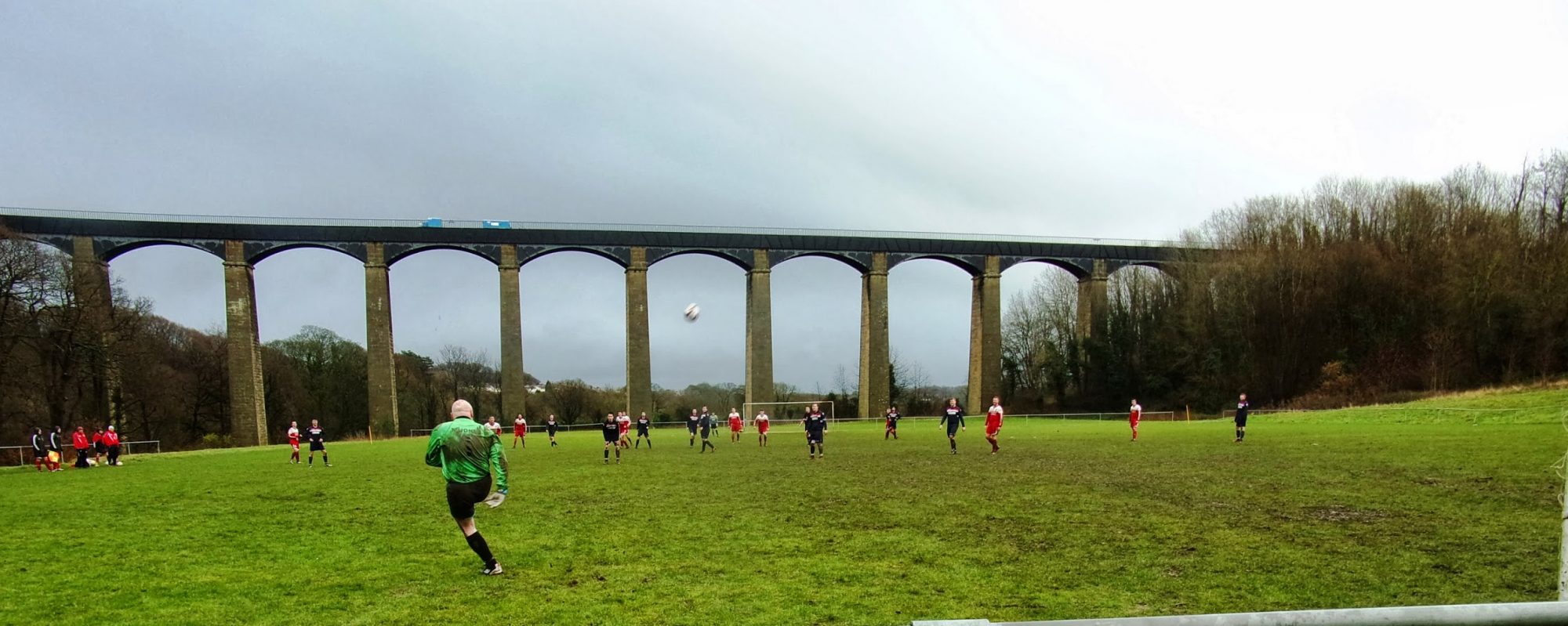I can’t believe it took me so long to get into non-league football and groundhopping. Having always had a fascination for stadia and a love of football it was a hobby just waiting for me. I used to get around the ’92’ following my team – and considered myself a groundhopper then; but I realise now that in limiting myself to the league grounds I was missing out on some of the finer aspects of football – aspects that have been diminishing fast from the league these last few decades
Watching non-league football is like going back in time to the football of yore (well – the eighties in my case). There are still old historic stands, grounds pieced together with mismatched but interesting stands, cellotape and hope. Programmes that are still individual to each club, and nearly always a great camaraderie and atmosphere. Non-league football is much more akin to the original philosophy and tenet of football than the league nowadays, and is a lot more enjoyable for it.
There’s none of the red tape and bureaucracy that’s appeared in the league game…and indeed the conference leagues to a larfge extent. You turn up, pay cash at the turnstile and you’re in. There’s no mindless queueing for tickets for a match that won’t sell out, no feelings of wretchedness at stumping up £3.00 for a homogenous, predictable programme with the same layout and stats as every other league club. The burgers don’t come microwaved in bags and the drinks aren’t bought from the same place that Virgin Trains buy theirs from. Modern league football has unfortunately gone the same way as most other aspects of modern life; the increase in money has decreased the character in direct proportion. It has become homogenised, sanitised…indefinably worse.
I used to be a regular fan, watching my team play week in week out. I watched Brighton from the early eighties, when they were in the top flight, and between about 1984 and 1990 barely missed a home game at the Goldstone Ground. The ground I took for granted as a schoolboy now feels iconic to me; looking back with a touch of bias, it’s one of the best most charismatic grounds I’d been to.
It was in 1990 I got the away bug and a real love for stadia. I’d packed my rucksack and went off to Preston’s Lancashire Polytechnic, 300 miles away from home, but in a football hotspot. At 18 I’d had a small taster of Brighton away games, short hops to Watford, Palace, Gillingham and Northampton Town, to name a few, but not many. With this new found independence, a grant, student loan and railcard, I went to 20 Brighton away games in my first year.
Although I regarded myself as a groundhopper at this stage, with a notion of completing the 92, I was vaguely aware of a different sort of groundhopper, in the same mould as trainspotters, the sorts that got together for Easter weekends where they’d speed furtively en masse from 11.30 Good Friday to between 11-14 different, inconceivably rare, non-league fixtures. I was pretty much a one man team though at this stage. If it wasn’t Brighton, I wasn’t that interested, finding neutral games generally dull, missing the essential element of fierce partisan passion.
Like a lot of ardent club supporters there were times during that season where I’d have a sudden realisation of what I was doing, like a drug addict coming to terms with his addiction. I distinctly remember having an epiphanic moment at Liverpool Street station; the only divine thing about it was realising how divinely stupid I was having spent 2 weeks’ living allowance travelling from Preston to Southend for Brighton’s fairly innocuous fixture at Roots Hall. We lost 2-1 in an interminably dull game, and despite scoring a consolation on 84 minutes, had had no further attacks.
This 20 away game season was 1990-91 which is to this day my favourite season – despite Southend, I couldn’t have picked a better time to take leave of my senses and travel everywhere on borrowed money to watch my team. It was one of our best away records ever (9-3-11) and we’d got to the play-offs thanks to the last kick of our season (a free kick by current manager Dean Wilkins). We then did the double over rivals Millwall in the semi-s (6-2 on aggregate). Getting the train to London twice in 10 days, first for the Den and then for Wembley were, for me, essential living costs.
The rest of the nineties, as any Brighton fan will tell you, were dire. From the first season of the nineties onwards we played increasingly worse, in increasingly lower divisions, all within the control of a dodgy chairman whose long term goals for the club were to sell the wonderful Goldstone Ground.
Despite this depression in Albion’s history there was still something noble about being a loyal fan of theirs. After Preston, I settled in Staffordshire but was still watching them all over the country. Despite almost every away game ending in defeat in these years, there was something edifying and character building about it. I felt like a true supporter, a martyr almost, travelling to places that I only knew from the vidiprinter, that inhabited that strange eldritch world at the bottom of division four – Rochdale, Chester, Halifax, Mansfield, Doncaster, York – I’d seen us lose to all of them.
I’d say from around the turn of the century onwards my patience with league football was starting to wear thin. Since 1993 the Premiership had been slowly poisoning football from the top down, like acid rain, soaking into the roots of football. The greedy demands of a few clubs who bullied the FA into reneging on one of the defining original principles of football, namely the sharing of revenue between all clubs, had killed top flight football as an interesting and competitive league.
This intangible dictator of football called money, was making its presence felt through all the leagues. At some point the gate money to watch Brighton crossed an invisible line between an amount you could laugh at yourself for paying after a bad game, to an amount that wasn’t funny anymore. Watching them would make me angry unless nothing short of a perfect performance was put in. The stadia, even in the bottom two leagues, were starting to look alarmingly smart and uniform, the programmes were no longer individual to each club, the formats all the same and the stats lifted straight from some generic website. Even the drinks all looked and tasted the same in the league now.
So in about 2006 I set about discovering all the non-leagues teams local to where I live, occasionally venturing further afield. I drew the line at step six of the pyramid, as below this level is mostly devoid of any stands and there is no requirement of floodlights. These are just pitches for me, not grounds. I have already exhausted all those within 70 miles, but widen the net a tiny bit further and another torrent of teams present themselves.
With there being 40 divisions down to step six, all with around 20 teams in, there is never a shortage of venues. Though you’d be surprised at how many full-time hoppers there are that have completed nearly all of them – it kinds of puts the ’92’ in perspective. I’m not in a position to reel off grounds at the rate of three a week, but I can never wait for the next game – a new place, new ground and always something different to take away from the afternoon or evening. It no longer matters to me that I don’t have a vested interest in one team – the matches are much more consistently good and entertaining than league football, and it’s quite a relief to be without all that emotional intensity.
It’s since going to non-league games regularly that I’ve noticed how stuffy and authoritarian league football has become. The fans have become de-humanised. Seeing a couple of gents chatting away pitch side at Buxton with a glass of whisky each in their hands makes you realise that in non-league the fans are still treated as the foundations of the club and afforded the respect that deserves, rather than just paid lip-service to when required.
At Brocton recently I was given a complimentary cup of coffee just for being a groundhopper. The hospitality is something that seems to be evident at all grounds in the lower leagues. The clubhouses and bars welcome everybody, glad of the gate money and interest shown in their club. As you wander pitch side you feel part of something great and worthwhile which football, of course, is.
I still watch Brighton occasionally but tend to limit it to previously unseen league grounds and the odd cup tie that pairs us away with a team whose ground I haven’t done. The majority of football I watch now though is between level three and six and if I was to pick a favourite I’d say step five – generally good games for little money at charismatic venues. I could never go back to league football full time now.

